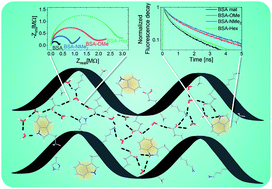当前位置:
X-MOL 学术
›
Chem. Sci.
›
论文详情
Our official English website, www.x-mol.net, welcomes your
feedback! (Note: you will need to create a separate account there.)
Exploring long-range proton conduction, the conduction mechanism and inner hydration state of protein biopolymers
Chemical Science ( IF 7.6 ) Pub Date : 2020/03/11 , DOI: 10.1039/c9sc04392f Somen Mondal 1 , Yuval Agam 1 , Ramesh Nandi 1 , Nadav Amdursky 1
Chemical Science ( IF 7.6 ) Pub Date : 2020/03/11 , DOI: 10.1039/c9sc04392f Somen Mondal 1 , Yuval Agam 1 , Ramesh Nandi 1 , Nadav Amdursky 1
Affiliation

|
Proteins are the main proton mediators in various biological proton circuits. Using proteins for the formation of long-range proton conductors is offering a bioinspired approach for proton conductive polymers. One of the main challenges in the field of proton conductors is to explore the local environment within the polymers, along with deciphering the conduction mechanism. Here, we show that the protonic conductivity across a protein-based biopolymer can be hindered using straightforward chemical modifications, targeting carboxylate- or amine-terminated residues of the protein, as well as exploring the effect of surface hydrophobicity on proton conduction. We further use the natural tryptophan residue as a local fluorescent probe for the inner local hydration state of the protein surface and its tendency to form hydrogen bonds with nearby water molecules, along with the dynamicity of the process. Our electrical and spectroscopic measurements of the different chemically-modified protein materials as well as the material at different water–aprotic solvent mixtures result in our fundamental understanding of the proton mediators within the material and gaining important insights on the proton conduction mechanism. Our biopolymer can be used as an attractive platform for the study of bio-related protonic circuits as well as a proton conducting biopolymer for various applications, such as protonic transistors, ionic transducers and fuel cells.
中文翻译:

探索长程质子传导、蛋白质生物聚合物的传导机制和内部水合状态
蛋白质是各种生物质子回路中的主要质子介体。利用蛋白质形成长程质子导体为质子导电聚合物提供了一种仿生方法。质子导体领域的主要挑战之一是探索聚合物内的局部环境,并破译传导机制。在这里,我们表明,可以使用直接的化学修饰来阻碍基于蛋白质的生物聚合物的质子传导性,针对蛋白质的羧酸盐或胺末端残基,以及探索表面疏水性对质子传导的影响。我们进一步使用天然色氨酸残基作为局部荧光探针,用于检测蛋白质表面的内部局部水合状态及其与附近水分子形成氢键的倾向,以及该过程的动态性。我们对不同化学修饰的蛋白质材料以及不同水-非质子溶剂混合物中的材料进行电学和光谱测量,使我们对材料内的质子介体有了基本的了解,并获得了对质子传导机制的重要见解。我们的生物聚合物可用作研究生物相关质子电路的有吸引力的平台,以及用于各种应用的质子传导生物聚合物,例如质子晶体管、离子换能器和燃料电池。
更新日期:2020-04-01
中文翻译:

探索长程质子传导、蛋白质生物聚合物的传导机制和内部水合状态
蛋白质是各种生物质子回路中的主要质子介体。利用蛋白质形成长程质子导体为质子导电聚合物提供了一种仿生方法。质子导体领域的主要挑战之一是探索聚合物内的局部环境,并破译传导机制。在这里,我们表明,可以使用直接的化学修饰来阻碍基于蛋白质的生物聚合物的质子传导性,针对蛋白质的羧酸盐或胺末端残基,以及探索表面疏水性对质子传导的影响。我们进一步使用天然色氨酸残基作为局部荧光探针,用于检测蛋白质表面的内部局部水合状态及其与附近水分子形成氢键的倾向,以及该过程的动态性。我们对不同化学修饰的蛋白质材料以及不同水-非质子溶剂混合物中的材料进行电学和光谱测量,使我们对材料内的质子介体有了基本的了解,并获得了对质子传导机制的重要见解。我们的生物聚合物可用作研究生物相关质子电路的有吸引力的平台,以及用于各种应用的质子传导生物聚合物,例如质子晶体管、离子换能器和燃料电池。











































 京公网安备 11010802027423号
京公网安备 11010802027423号